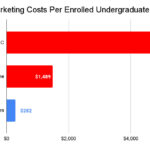 Education
Education
Exorbitant Costs, Little Benefit: $5,000 Marketing Cost Per Student at UAGC with Low Academic Success
June 28, 2024
The Grand Canyon Institute (GCI) reviewed the analysis of online education at the University of Arizona commissioned by the University and Board of Regents and completed by Ernst and Young (E&Y). The report was only available via a public information request. University of Arizona CFO John Arnold’s presentation to the Board of Regent on Friday, June 20 focused on this report. While this paper examines the same report, the information focused on here was not part of that presentation. Whether the Board had access to the full report is unknown, but the Board had no questions after the presentation (the presentation runs from the 3 hour mark to 3 hours and 12 minutes at the YouTube link).
A careful reading of the E&Y report, as well as what it fails to focus on, reveals serious shortcomings in online education at University of Arizona Global Campus (UAGC).
The University has two online programs. Arizona Online is the pre-existing online program. It has been gradually growing and currently has more than 9,000 students. The online offerings from for-profit Ashford University that was acquired and rebranded as UAGC in November 2020 run separately from Arizona Online.
Key Findings:
- UAGC relies substantially on paid leads to recruit students and its marketing costs are more than $5,000 for each undergraduate student who enrolls.
- Arizona Online pays just $1,500 in marketing costs for each undergraduate student who enrolls.
- By contrast, public institutions typically pay less than $300 in marketing costs to enroll a student, making online marketing costs for Arizona Online 5 times greater and UAGC more than 15 times greater.
- For first-time, first-year students, the six-year completion rate is about one-fourth of the rate for on-campus students for both Arizona online and UAGC
- The Ernst & Young report fails to flag the dramatic drop in enrollment at UAGC (14% per year) since the takeover as an area of concern.
- While UAGC has broken even, it does so because it relies almost exclusively on low paid adjunct faculty who are usually paid less than $2,000 per course.
- Investigative research by the Arizona Republic based on former students interviewed raises concerns about the integrity of UAGC since the University of Arizona took over.
Read the Full Policy Paper Here.
Note: Graph and figure updated from initial release.
For more information, contact: Dave Wells, Research Director, Grand Canyon Institute, at DWells@azgci.org or at (602) 595-1025, Ext. 2.
The Grand Canyon Institute (GCI) is a nonpartisan, nonprofit organization dedicated to informing and improving public policy in Arizona through evidence-based, independent, objective, nonpartisan research. GCI makes a good faith effort to ensure that findings are reliable, accurate, and based on reputable sources. While publications reflect the view of the Institute, they may not reflect the view of individual members of the Board.
